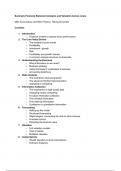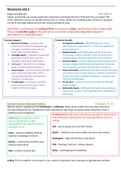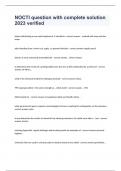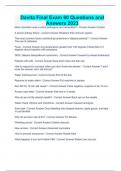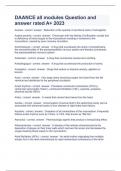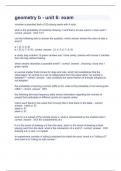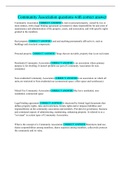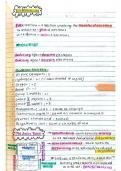NURSE EXECUTIVE CERTIFICATION WITH
**
COMPLETE SOLUTIONS 100%**
**Trait Theory**
Effective leaders often share traits such as self-confidence, responsibility for their actions,
persistence, creativity, initiative, resilience, tolerance, influence, social structuring abilities,
intelligence, integrity, nonconformity, cooperativeness, and tact.
**Behavioral Theory**
This theory examines leadership based on behavior and categorizes leaders into styles such as:
- **Autocratic**: Leaders who use control and authority to direct subordinates.
- **Democratic**: Leaders who involve subordinates in decision-making and goal-setting.
- **Permissive/Laissez-Faire**: Leaders who allow subordinates to make decisions
independently.
- **Bureaucratic**: Leaders who rely on policies and rules to guide behavior.
**Likert’s System 4 Management**
A model that demonstrates how employee involvement correlates with organizational
commitment and outcomes.
- **Impoverished Leaders**: Minimal concern for production or people, doing the least
necessary.
**Contingency Theory**
Also known as situational leadership, it involves adapting leadership styles based on the
situation.
- **Manager-Follower Relationships**: Reflects the loyalty and support between manager and
followers.
- **Task Structure**: Clarity of task description and procedures.
- **Position Power**: Manager’s ability to reward or punish.
- **Job Maturity**: Employee’s skill level relative to the task.
- **Psychological Maturity**: Employee’s self-confidence and respect.
**Hersey and Blanchard Leadership Styles**
- **S1 - High Task/Low Relationship (Telling)**: Leader directs and supervises closely.
- **S2 - High Task/High Relationship (Selling)**: Leader makes decisions while coaching.
- **S3 - Low Task/High Relationship (Participating)**: Leader and follower collaborate.
- **S4 - Low Task/Low Relationship (Delegating)**: Follower has autonomy.
**Vroom-Yetton's Expectancy Theory**
,Provides a framework for deciding the level of employee participation in decision-making using
various approaches: telling, selling, consulting, joining, or delegating.
**Charismatic Leaders**
Engage others through their personality, inspiring emotional connections and advancing ideas.
**Transactional Leaders**
Focus on exchanges between managers and employees to maintain balance and status quo.
**Transformational Leaders**
Drive organizational change through contextual and cultural shifts, encouraging risk-taking and
self-actualization.
**Connective Leaders**
Use collaboration and coordination to bring people together, overcoming hierarchical obstacles.
**Shared Leadership**
Empowers informal and formal leadership roles, emphasizing self-directed work and shared
governance.
**Servant Leadership**
Prioritizes the needs of others over the leader’s own interests, focusing on stewardship.
**Transparency**
Encourages openness and trust through access to information and participation in decision-
making.
**Organizational Structures**
- **Matrix Structure**: Departments are listed equally.
- **Horizontal Structure**: Limited chain of command with autonomous managers.
- **Committee Structure**: Authority and responsibility are shared by a group.
**Types of Businesses**
- **Sole Proprietorship**: Owned by one person.
- **Partnership**: Owned by two or more individuals.
- **Corporation**: Owned by stockholders who are not personally liable for its debts.
**Classical Principles of Organizational Theory**
- **Chain of Command**: Unbroken line from top to bottom.
- **Unity of Command**: Each subordinate reports to one superior.
- **Span of Control**: Scope of responsibility for a supervisor.
**Management Theory**
Focuses on planning, organizing, staffing, leading, controlling, and coordinating to achieve
outcomes.
,**Frederick Taylor**
Pioneered scientific management through standards, time-motion studies, task analysis, job
simplification, and productivity incentives.
**Henri Fayol**
A proponent of the management process school, emphasizing overall organizational competency.
**Narrow vs. Wide Span of Control**
- **Narrow**: Required for complex tasks.
- **Wide**: Suitable for routine tasks with minimal supervision.
**Family and Medical Leave Act (FMLA)**
Requires employers with 50+ employees to provide up to 12 weeks of unpaid leave for medical
or family reasons, with job protection and benefits maintenance.
**Americans with Disabilities Act (ADA)**
Prohibits discrimination and mandates accommodations for individuals with disabilities.
**Fair Labor Standards Act (FLSA)**
Sets standards for minimum wage, overtime, and child labor.
**Additional Acts**
- **Davis-Bacon Act**: Prevailing wages for public works.
- **Walsh-Healy Act**: Overtime and minimum wage for government contracts.
- **Contract Work Hours and Safety Standards Act**: Overtime pay and safety standards.
- **McNamara-O'Hara Service Contract Act**: Prevailing wages for service contracts.
- **Federal Wage Garnishment Law**: Limits on wage garnishment and job protection.
- **Equal Opportunity Commission (EEOC)**: Enforces anti-discrimination laws.
**Civil Rights Acts**
- **1964**: Outlaws discrimination based on various factors.
- **1991**: Amends the 1964 Act, easing lawsuit processes and limiting damages.
**Equal Pay Act (1963)**
Requires equal pay for equal work regardless of gender.
**Age Discrimination in Employment Act (1967)**
Protects workers aged 40 and above from discrimination and mandatory retirement.
**Genetic Information Nondiscrimination Act (GINA)**
Prohibits discrimination based on genetic information.
**Occupational Safety and Health Administration (OSHA)**
Regulates safety and health standards in the workplace.
**Workers Compensation**
, Insurance providing cash, medical cost reimbursement, and death benefits for job-related
injuries.
**Omnibus Budget Reconciliation Act (OBRA)**
Sets standards for nursing assistant training, staffing, and resident rights.
**Older Americans Act (OAA)**
Improves access to services for older adults and native Americans.
**Emergency Medical Treatment and Active Labor Act (EMTALA)**
Prevents patient dumping and mandates stabilization before transfer.
**Collective Bargaining**
Negotiation process regarding salary and working conditions, governed by federal and state laws.
**Types of Collective Bargaining**
- **Distributive**: Competitive, zero-sum approach.
- **Integrative**: Collaborative, win-win approach.
- **Mixed**: Combines elements of both.
**Collective Bargaining Agreement**
Documents the negotiated terms between administration and labor union.
**Employment Grievances**
Disputes regarding employment terms, escalated through a formal grievance process.
**Grievance Arbitration**
A third-party arbitrator resolves disputes through hearings and decisions.
**National Labor Relations Board (NLRB)**
Protects workers' rights to organize and prevents unfair labor practices.
**Cross Training**
Training staff to perform multiple jobs to improve efficiency and cover absenteeism.
**Accordion Schedule**
A flexible scheduling system to accommodate multiple absences.
**Job Description**
Outlines duties, responsibilities, and required skills for a position.
**Employee Assistance Program (EAP)**
Provides support for personal or work-related issues affecting job performance.
**Performance Management**
Includes planning, coaching, and assessing performance to meet goals.


